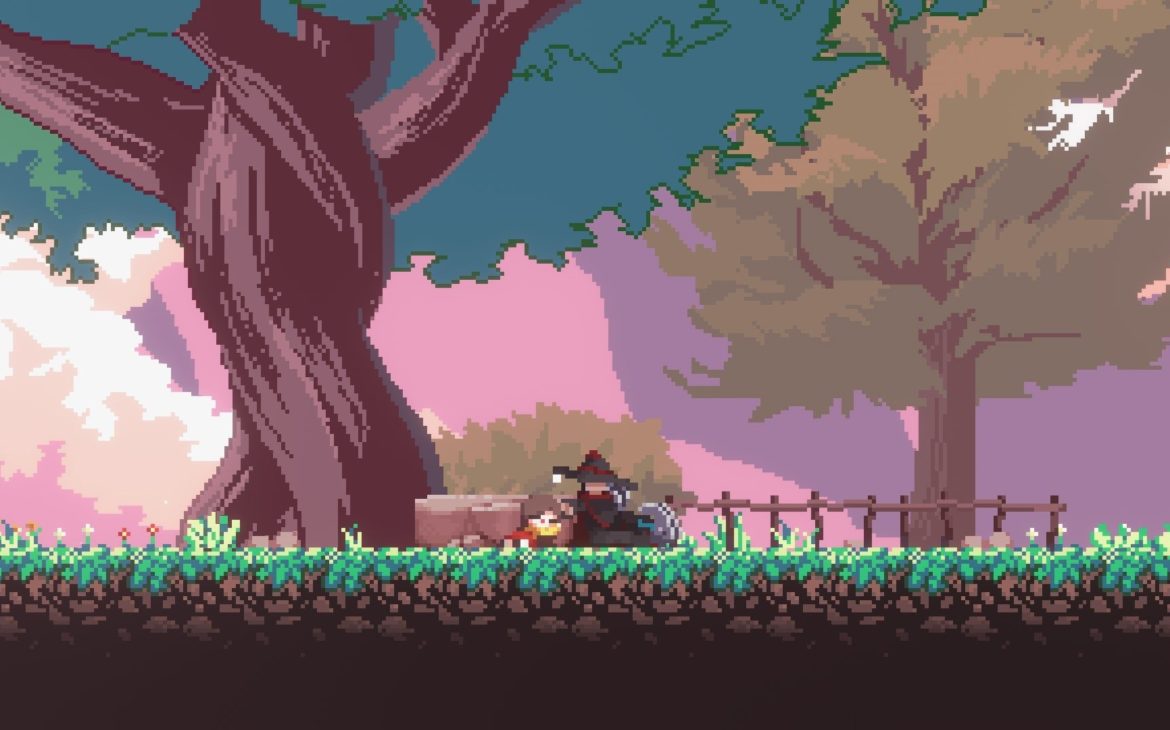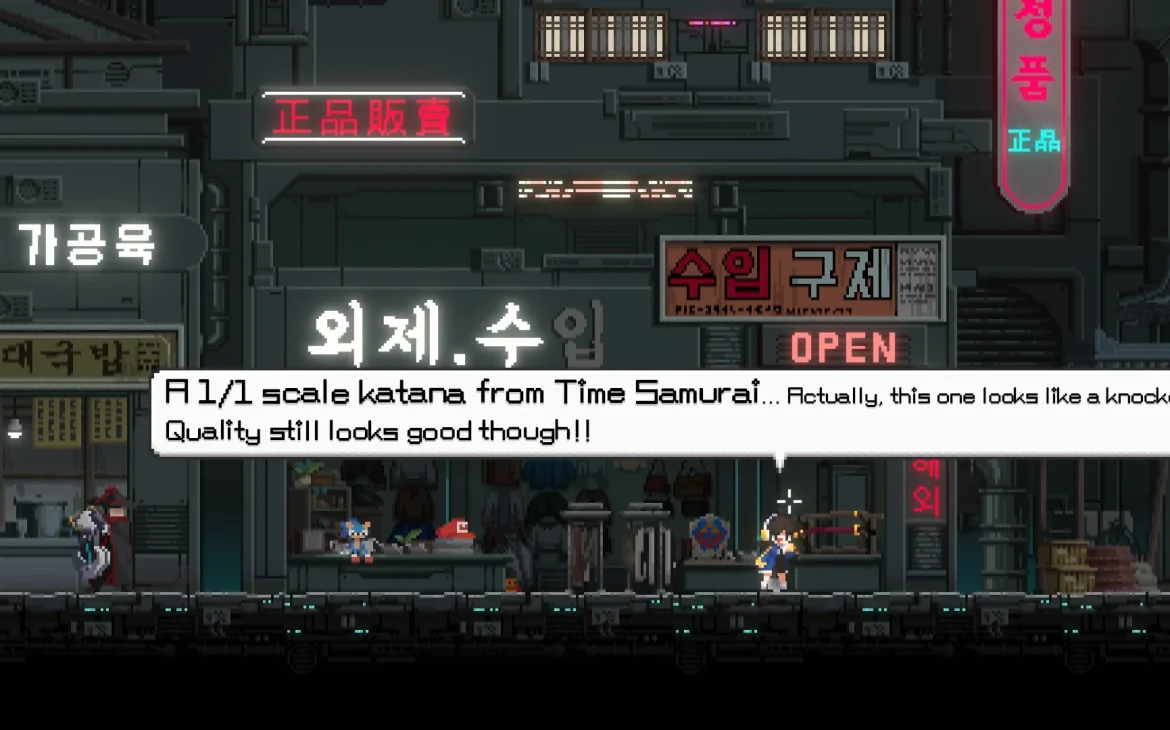I’ve said before about a “renaissance” in 2D, pixel/voxel-style games and the intertwining of ultra-violence against a nostalgic background. But renaissance suggests it might then fade again, which wouldn’t be fun. Thankfully, games like SANABI are keeping that flame burning bright.
Joining the ranks of Katana Zero, Blasphemous and The Messenger, SANABI is another glorious slice of 2D violence, uber-stylish visuals and slick writing, all to a foot-tapping electro soundtrack. Not convinced? What if I said the words “Bionic Commando but better” to you…?
Well, if that’s not enough to hook you in (pun intended), grab on and find out if SANABI is worth hanging on to.

The Story Hook[shot]
SANABI is by no means original when it comes to setting its tone, or even a narrative framing device. It begins with our hero, the retired general, being all twee with his daughter in their garden. Odd how the daughter is unfazed by dad looking like a cross being Vampire Hunter D and a The Surge boss, but we swing with it.
Soon after twee playtime comes to an end, so does the scene of idyllic family life as seen in Commando. You know the drill: villain from past shatters family life, unnamed protagonist gets drawn back into life once behind.
The villain in this case being the eponymous SANABI, now the ruler of a mega-city, the weirdly named Mago City, presumably to avoid irking the Judge Dredd fans. It’s here our journey begins… well, after some hookshot tutorials to get us swinging.

The Aerial Ballet
When I say that the hookshot/arm (hook-arm?) mechanic is a strong focus in SANABI, I mean it’s the whole shebang. Bread, butter, filling: it’s the core combat to its gameplay. Again, to use the Bionic Commando reference, it’s a mastery of swinging and traversal that players will need to get to grips with.
It’s a simple enough concept: the levels of Mago City are big, surprisingly vertical and have a lot of electrified floors. You, the sullen and broody soldier, will be navigating these without falling into pitfalls or being fried. Fortunately, and unlike a lot of other trial and error games of this ilk, players have four life blocks rather than the “one hit kill” method of frustration.
Swinging is a pretty simple affair: aim with the left stick, like Yoshi’s egg-throwing cursor, and press the right trigger/bumper. As time goes on, they’ll be a brief time-slowing aide with the right stick for precision shots, but that’s it. You point, you fire, you George of the Jungle your way around a neon dystopia. Pair that with some Celeste-ian wall-hopping and you’re getting the picture.
Yet whilst that sounds easy enough, players aren’t in for an easy… err, swing.

Grabbed By My Strong Hand
Unlike Bionic Commando, or any game that has a swinging/shooting mechanic, SANABI is a little different in its combat methods. For one, mainly, there’s no shooting. The unnamed protagonist carries no gun, no Barret-like gun-arm extensions to interchange like violent KNEX pieces. No, here it’s a more violent version of those claw arcade games.
Much like the traversal mechanic, SANABI employs the same tactic against enemies. You aim, you fire, you draw yourself to whatever foe you’ve hooked like some miniature Attack on Titan attack. But here’s the kicker: it doesn’t immediate kill said enemy.
Instead, it’s only by releasing the grapple button that it kills whatever we’re attached to. Sounds daft, but this is where tactics come in. Pairing combat and movement to one mechanic creates a stream of consistent movement. It’s in these moments that the game shines, encouraging that whirling dervish style over hiding on a ledge somewhere.
So, when it does a Ghostrunner and hides progression behind a room of enemy robots and turrets, I was more interested in zipping about and grappling into foes with murder-hugs than idling and “planning” anything.

“I’m A Lonely Loner, I Do Things… Alone”
Much as I am enjoying SANABI, there is only a certain amount of cliché I can put up with. Unfortunately, that’s where a lot of the dialogue falls into familiar and corny territory.
Now, this can in part be put down to the small development team based in South Korea. As we’ve learnt over the years with mistranslations and regionalisation, some mannerisms and tone can be lost… well, in translation. That being said, SANABI can sometimes be eye-rolling in its approach to things.
Our hero is blunt, broody and sullen. By contrast, his manic-pixie-hacker-girl is every bit as that description gives. The dialogue contrasts out minimalist hero, but sometimes too far with its “OhmygodIcandothehackingbutdon’tcallmeahacker” schtick. It’s endearing, sometimes funny, but mostly had me just wanting to skip it.
That being said, the story is engaging enough. Our protagonist on a death wish being drawn into something deeper does entice, and I won’t spoil. Just bear in mind that it can be a bit cringeworthy at times, is all.

Swinging To The Beat
I’ve laid on thick before about being an 80’s kid, and with that a love for synth/electronica thus grew. It’s partly what drew me to SANABI in the first place: the bombastic synthwave used in the trailer.
Which, I am happy to report, continues throughout the game. Honestly, it’s a joy swinging about and bashing enemies to such a vibrant and thumping soundtrack. Again, it invokes more modern titles like Katana Zero, Hotline Miami and even Ghostrunner. Specifically the latter with the whole neo-city arrangement.
In tandem, the graphics being crisp and able to get up with the high speed gaming make it a joy to play. As well as those aforementioned modern games, it took me back to older days too. Games like the SNES Contra’s/Probotectors, Alien Storm and the like.
Are games like this deliberately evoking that nostalgia to draw us in? Oh, without a doubt, and it totally works. But would this appeal to someone who doesn’t have those old-school comparisons? I’d say so, as 2D and Metroidvania are on an absolute high right now.

Get Hooked In
To conclude on this short review, as it’s a simple enough game, SANABI is my new favourite “2D renaissance” game. There’s a reason I’ve referenced the modern alternatives earlier, as they’re all games I love. Yes, reviews are subjective and you may not agree, but using them as comparisons should give you an idea.
I haven’t finished SANABI yet because, y’know, life and whatnot. But, again to use Hotline Miami, it has that hook (yes, intended) that makes me want to keep at it. It’s got the looks, it’s got the tunes, and whilst the story is familiar territory, the fast-paced gameplay loop makes it enjoyable.
If you are looking for something new-but-old, familiar-yet-different, then SANABI will hit that spot. Don’t take it too seriously, play it with headphones on and you’ll be hooked. Yeah, I can’t help it.
Riding that 2D renaissance wave, SANABI is another neon-soaked platformer that deserves a look at. Gorgeous pixel visuals, fast-paced gameplay and a cracking soundtrack, there’s something for old-school fans and newcomers alike.

SANABI is available now on PC via Steam (review platform) and Nintendo Switch.
Developer: WONDER POTION
Publisher: Neowiz Games
Disclaimer: In order to complete this review, we were provided with a promotional copy of the game. For our full review policy, please go here.
If you enjoyed this article or any more of our content, please consider our Patreon.
Make sure to follow Finger Guns on our social channels –Twitter, Facebook, Twitch, Spotify or Apple Podcasts – to keep up to date on our news, reviews and features.
